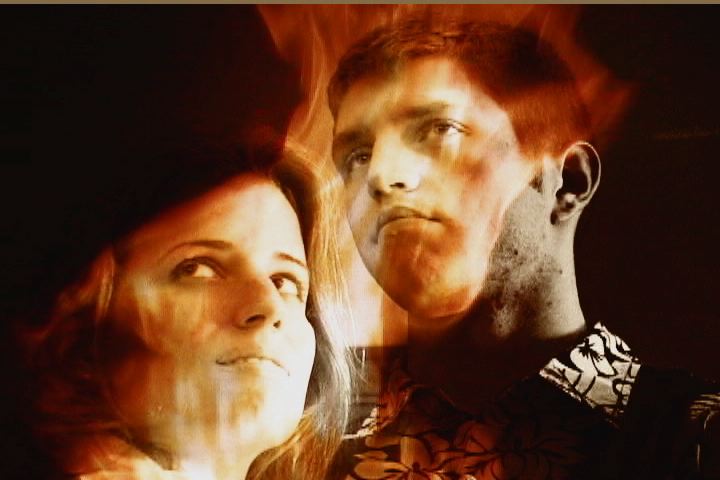
My Film School
Written by Scott R. Caseley | Posted by: Anonymous
I took a job at a local video store. After a while, I was listless and not focusing on the goal of being a filmmaker. I had been disenfranchised by the failure of Trust Fall. I started to think that this was it for me — I was destined to work paycheck to paycheck. Then, I met Robert J. Lalime who quickly became my best friend and one of the biggest supporters I have ever met. I let him borrow a copy of Trust Fall and he came back and sang its praises. He told me that I needed to make another movie.
I kept trying to think of ideas, and it was going nowhere. I thought of stories big and small, but nothing felt right. My mind was clouded but without the rain of creativity to bring on that elusive rainbow. Then, in the middle of severe writer’s block, my appendix burst, which altered my life and the course of my film “career” as it were.
While in the hospital, I started to think of my own mortality and life after the video store. I realized that I really needed to make another movie. I had vacation coming up the week following my recovery. I began writing the story of Larry, a young man who dreamed of two things, becoming a filmmaker and more seriously a recurring nightmare of his own death. He didn’t quite understand the meaning behind this second dream, but more importantly, he didn’t understand himself. I finished the first draft in five days, and passed it off to Rob. He devoured it and said, “Yes, this is the way to go.”
I quickly started to put up ads on NewEnglandFilm, looking for actors/actresses to audition. With the help of Jeremy Banks, a classmate at Franklin Pierce, we set out in earnest to make the film. He became my producer and would play Kurt, the goofy best friend of Larry, who thinks of nothing but sex and loyalty. Ironically, casting Larry was the easiest casting choice. He was to be realized by Rob. He had never acted in a film before, but I had a strong feeling about him based on some improvisational games that he and Randy had done with me sometime before. He now has eight films on his resume.
During the audition process, I met Eric M. Lalonde, a firefighter/EMT from Chicopee, MA. He was perfect for Larry’s overbearing father who really loves him but doesn’t know how to express his feelings in a positive way. I recently asked Eric what made him decide to audition for me. He explained, “What caught my attention was the struggle of a widower raising a son by himself and trying to maintain a balance between his professional life and his sometimes chaotic home life.”
We began shooting in June of 2001. We shot the movie from start to finish in 16 days. Originally, the goal was to make a Dogma-style film based on the works of Lars Von Trier, a filmmaker that my cinematographer Christian de Rezendes really responded to. We had a lot of varied locations in southern New Hampshire and central Massachusetts, some really inspired performances, and some wonderful cinematography provided by Christian’s VX-1000 Mini DV Camcorder. We had trouble finding an editor at first. So, in my spare time, I decided to work on a bunch of other local movies, where I was everything from a production assistant to a first assistant director. I learned much about the craft through working with local filmmakers.
Due to certain circumstances, I had to re-shoot half the movie over again with a new lead actress. I found Cristina Cammarata during this process. It was going to be two years after the original shoot, so I wasn’t sure whom I would be able to get back again. Fortunately, Rob, Jeremy, and Eric returned to act for me again along with a couple others, and Christian was back behind the camera. On August 4, 2003, I took to the set with this mixed crew made up of people I met through NewEnglandFilm.com and the original shoot. Things went much more smoothly from the start, even from the point of view of the new Lisa, who said, “The cast and crew were wonderful and made me feel really comfortable.”

Lalime runs lines with Caseley on location in Hudson, NH.
[Click to enlarge]
Realizing that I could have a second go at this, and a chance to improve upon the scope of the movie with this redux, I decided to enlist the help of John Campanello of BetweenGigsCasting whom I had met when we worked together on another New Hampshire film. His company provides talent casting support for film, commercials, radio, and print. He has a large network of talent and production resources in New England, and he used that to help get the word out.
John literally helped me find scores of people. All totaled, we had 62 actors, actresses and extras in the film. I even gave speaking parts on location to people that I felt possessed a certain quality. I credit him immensely for giving my made-up town a certain New England feel with finds like Brian Quint, Jim Rogato, Andrea Leone and more.
The second time around, I knew exactly what I wanted and how to communicate it. After we finished shooting, I watched the footage with new confidence. It had come out so much closer to my original vision. I think that my cinematographer and I communicated better, my crew hadn’t let me down, and my cast was phenomenal. Once I found the right editor in Sean A. Doyle, we went through and edited the film in about a month and a half. And once seeing that cut, I was ready to move onto the business of dressing up our footage.
I found an incredible composer in Bob Lord, a bassist from the award-winning band Dreadnaught. He was also a licensor of other bands and singers from all over New England. He helped me fill out the rest of the musical range by providing me with music from the soulful Tess Walsh, some wonderful worldly music from Fluttr Effect, a fun, upbeat band called Zox, a folk singer named Dave King who provided the song that would be really an anthem for the coda to the movie, “These Are The Good Times.” My cousins also contributed five songs from their Sand Machine albums. With all of this, we were able to have a progressive rock based score and soundtrack.
Sound design was completed by two key individuals. Peter Stevenson gave me a lot of ideas for how to improve things and have sound really be an accompaniment to a visual. Many other audio engineers I had met before had wanted to overshadow the visuals with over-the-top sound. He helped me realize that what the film needed most was an organic feel for everything. So, when I went to my final sound mix, I was able to tell engineer Drake Giles exactly what I was listening for. He swept through the 77-minute film and really took the elements of surrealism from Larry’s nightmares and moments of inspiration, giving each thread a separate feeling from his day-to-day dreary life.
When I knew that I had a story that delved into both reality and the surrealism of one’s imagination, I knew that I would have to get some special effects to illustrate this. That was when I found the incomparable David Victory. He understood his mission right away and was able to deal with my evolving vision. His high-tech account of his contribution is as follows: “I was asked to replace some trademarked images which had gotten into various shots, with original ones… In addition, empty painting frames in different scenes throughout the film needed to be filled with different images relevant to the story… smoke and a muzzle flash were needed in one scene, and a faux newspaper article needed to be animated. As time went on, there were other effects added, including glowing auras and wispy sprites.”
Finally, after all the sound was mixed, and the shots were peppered with visual effects, one step remained. This was to be a final color correction. Because we had used natural lighting, we had some bleeds from fluorescents and incandescents. We also had to account for the different moods from such a bizarre story. We had flashbacks, dreams, nightmares, delusions, and cold reality. This was a tall order for a colorist to handle. Fortunately, Dave Langley from TeamHill Studios was up for the challenge.
“For the color correction I used the basic tools available natively in After Effects, e.g. curves and levels etc. Other techniques used included rotoscoping, match moving and compositing. One shot required the removal of a fly buzzing around Kurt’s face in a close up flashback sequence. Several shots required painting replacement reflections in Kurt’s sunglasses. On another shot we needed to remove extremely noisy original footage shot at night with a daytime shot that I converted to night.”
Now, seven years after it all began in a hospital bed, Larry’s Home Video is ready to be seen by the world. It started out as one person’s dream, but it became the task of hundreds to realize this vision. Many obstacles arose during this process, ones that we all had to go through to get to this point. I believe we have all worked together well to make this movie something that we all can be proud of, and hopefully inspire others to pick up a camera themselves and contribute to the ever-growing cinematic canvas, even if they don’t have a film school background.
Larry's Home Video premieres on November 3rd at the Stockbridge Theatre at Pinkerton Academy in Derry, NH with giveaways, raffles and cast and crew Q and A. It starts at 8 pm, doors open at 7 pm. Reserve seats by e-mailing larryshomevideo@aol.com. More info at www.larryshomevideo.com.










